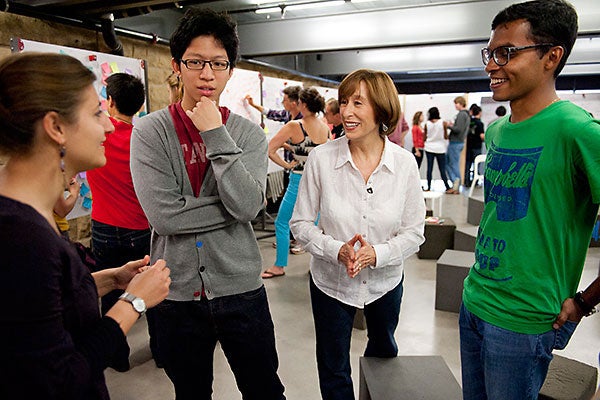|
View video here.
April 30, 2012
Where does that creative spark come from? Stanford's Tina Seelig has some ideas
In her new book, Tina Seelig provides tools and techniques to enhance creativity in individuals, teams and organizations. By Brooke Donald

From left, Victoire Lejzerzon, Titus Seah, Tina Seelig and Ramprasath Palanisamy talk about the results of a group exercise in class. (Photo: L.A. Cicero / Stanford News Service) Tina Seelig teaches people how to get their creative juices flowing. She's done this for the past dozen years with students at Stanford and at companies around the world.
Now, in a new book, she compiles her lessons for the rest of us – using exercises from her classroom, studies from scholars, guidance from innovative colleagues and her own insights.
The book, inGenius: A Crash Course on Creativity, does not provide a 10-step list of what to do to be creative – such as painting your office blue or moving the restroom to the center of your building. Seelig says those kinds of lists only lead to disappointment.
Rather, chapter-by-chapter it explains specific tools, techniques and conditions that together enhance creativity in individuals, teams and organizations.
Seelig offers a new model, called the "Innovation Engine," to explain how ingenuity is generated and fostered.
"It is terribly frustrating to hear people describe themselves as not creative. If you consider it, each sentence we utter is a creative act," Seelig said in a recent interview. "We need to look at every problem, every product and every moment in our lives as an opportunity for creativity."
By doing this, Seelig says, we are better equipped to tackle problems at home, work, school and in our communities.
"The world is filled with challenges. With enhanced creativity, we can look at those problems as opportunities," she said.
Seelig began writing this latest book two years ago, but her interest in the origins of creativity stretch back to her time as a doctoral student in neuroscience at the Stanford School of Medicine. There, she was interested in the neurological underpinnings of creativity.
After completing her studies, she wanted to see how creativity worked "in the wild." She worked as a management consultant, multimedia producer and entrepreneur.
Seelig is now the executive director of the Stanford Technology Ventures Program in the Department of Management Science and Engineering. The program helps students across campus learn the skills needed to bring their ideas to life.
She also co-directs the Mayfield Fellows Program with Tom Byers, a professor of management science and engineering, and teaches a course on creativity and innovation at the Hasso Plattner Institute of Design at Stanford (the d.school) with Leticia Britos and Rich Cox.
The creativity course is essentially a laboratory. Students run through simulations or experiments aimed at finding solutions to a wide variety of problems or creating interesting new opportunities.
Recently students did a case study focused on the circus industry. They examined all of the assumptions of a traditional circus and then turned those upside down. They saw how Cirque du Soleil used a similar approach to reinvent the circus industry.
Once the students learned these techniques, they used them to challenge assumptions in a wide variety of cases, including assessment of student learning.
Seelig's approach to unlocking creativity is a holistic one. Her "Innovation Engine" has six parts – three that come from inside of you (knowledge, imagination and attitude) and three that are generated by the environment in which you live (resources, culture and habitat).
"These are not isolated factors. You have to look at them in concert," Seelig said.
Knowledge, she says, is the toolbox for your imagination; your imagination is the catalyst for the transformation of your knowledge into new ideas; and your attitude provides you with the drive needed to push through difficult problems.
Our habitats have a huge impact on this process, and we are deeply influenced by space, rules, rewards, resources and culture, Seelig says.
In her book, Seelig reminds us that children are uninhibited innovators, full of curiosity. They tap into their natural creativity all day long, as they find ways to make sense of the complicated world around them. They also spend time in stimulating environments, including preschools filled with toys.
But, Seelig writes, as we grow, "We give up playing and focus on producing, and we trade in our imagination in order to focus on implementation. Our attitude changes and our creative aptitude withers as we learn to judge and dismiss new ideas."
Seelig provides tools for getting back the childhood sense of wonder and amusement. She also offers a lesson from her class to demonstrate that everything around us is ripe for innovation.
On the first day of class, Seelig asks the students to redesign a nametag. Current tags are difficult to read, don't have relevant information and often hang awkwardly down around the wearer's belt buckle.
When the students are done, Seelig asks them to think about the problem differently. "Why do we use name tags at all?" she says.
After a discussion in which they realize that nametags address a set of complex social problems, they are asked to design a new "introduction device."
Students interview each other to learn how they want to engage with new people and how they want others to engage with them. These interviews provide insights that lead to new solutions. One team designed T-shirts with a mix of information about the wearer in both words and pictures. Another team created bracelets that communicate how each person is feeling.
"We all have creativity within us," Seelig argues, "and there are endless opportunities to use it.
-30-
|